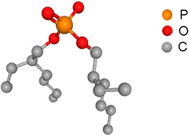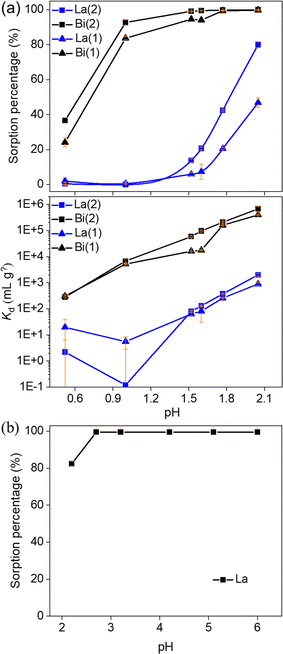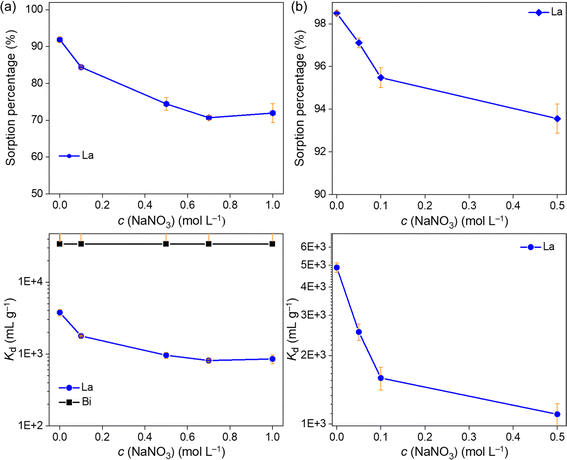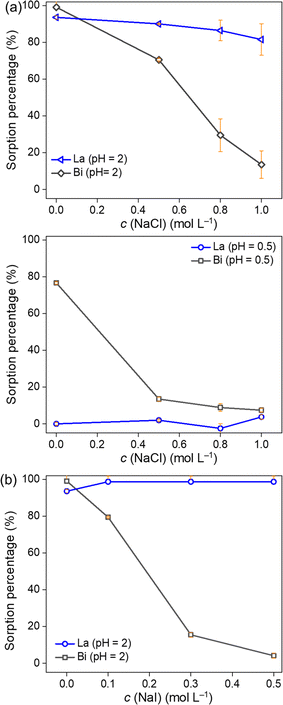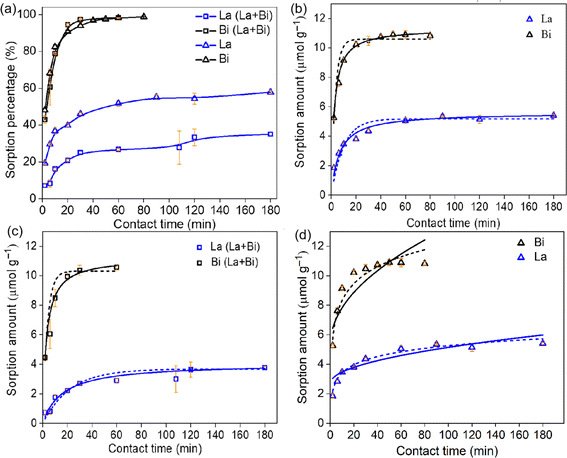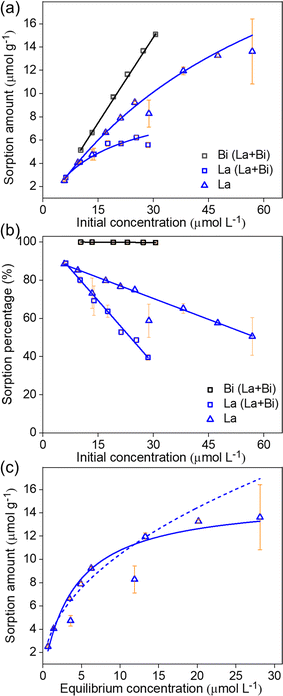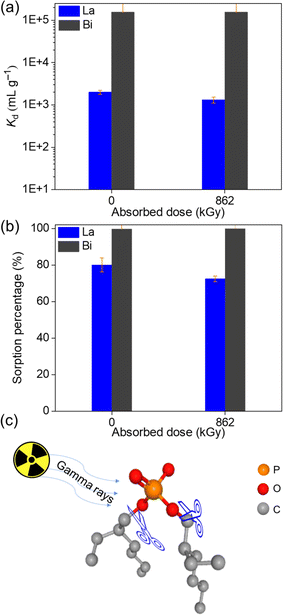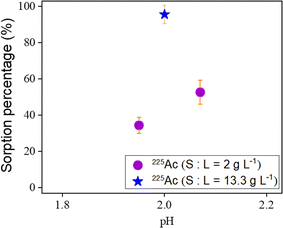 Open Access Article
Open Access ArticleStudy on the sorption and desorption behavior of La3+ and Bi3+ by bis(2-ethylhexyl)phosphate modified activated carbon†
Hongshan Zhu abc,
Stephan Heinitz
abc,
Stephan Heinitz a,
Koen Binnemans
a,
Koen Binnemans b,
Steven Mullens
b,
Steven Mullens c and
Thomas Cardinaels
c and
Thomas Cardinaels *ab
*ab
aBelgian Nuclear Research Centre (SCK CEN), Institute for Nuclear Materials Science, Boeretang 200, B-2400 Mol, Belgium
bKU Leuven, Department of Chemistry, Celestijnenlaan 200F, P. O. Box 2404, B-3001 Leuven, Belgium. E-mail: thomas.cardinaels@kuleuven.be
cFlemish Institute for Technological Research (VITO NV), Sustainable Materials Management, Boeretang 200, 2400 Mol, Belgium
First published on 1st November 2024
Abstract
The separation of 213Bi from its parent radionuclide 225Ac via radionuclide generators has proven to be a challenge due to the limited performance of the current sorbents. This study evaluated the separation performance of La3+ (as a surrogate for 225Ac) and Bi3+ using bis(2-ethylhexyl)phosphate monofunctionalized activated carbon (HDEHP/AC). The potential applications of phosphate groups as active sites and the carbon structure as a sorbent support were confirmed and validated. Various factors, including pH values, salt concentration, halide ions, contact time, solid-to-liquid ratio, initial La3+/Bi3+ concentration, and gamma irradiation were examined through batch sorption experiments in both single and binary systems. HDEHP/AC had a high sorption capacity for La3+ via electrostatic attraction, with the sorption data fitting well to the pseudo-second-order kinetic equation and Langmuir model. The sorption performance of La3+ on HDEHP/AC was minimally affected as the NaCl/NaI concentrations increased at pH = 2, whereas the sorption capacity for Bi3+ decreased significantly. Additionally, selective desorption of La3+ and Bi3+ was achieved using HNO3 and NaI solutions, respectively. These results backed up by a conceptual separation process point toward a potential use of these materials in a direct/inverse 225Ac/213Bi radionuclide generator. Further optimization of the material and separation process will be required to bring this class of promising materials into an actual generator for medical applications.
1. Introduction
The short-lived radionuclide 213Bi (t1/2 = 45.61 min) has received increasing attention for targeted alpha therapy for cancer treatment due to its favorable physical and radiobiological properties.1–3 It undergoes a series of alpha- and beta-decays to the near-stable isotope 209Bi (t1/2 = 1.9 × 1019 years), without long-lived intermediates.4,5 Specifically, the decay of 213Bi, with a branching ratio of 97.86%, leads to a pure alpha-emitter 213Po (t1/2 = 3.708 μs), which emits high-energy alpha-particles (approximately 8 MeV).5,6 213Bi-radiopharmaceutical plays a crucial role in delivering a high radiation dose to the targeted cancer cells.7 Currently, 213Bi is produced directly by the decay of the relatively long-lived radionuclide 225Ac (t1/2 = 9.920 days), which can be subsequently separated by radionuclide generators.1,8 However, the separation of 213Bi from 225Ac occurs in harsh conditions, posing stringent requirements on the performance and life-time of the sorbents used in the generators. Despite the fact that a range of sorbents have been investigated for this application, issues of low resistance to radiolysis and poor chemical stability make the separation of medical grade 213Bi in many cases a challenge.9–11 Considering these limitations, the development of alternative sorbents and the optimization of the related separation process are of great importance for the further development and implementation of targeted 213Bi therapy.9Understanding the interactions between active sorption sites and radionuclides is a key strategy for developing alternative materials and optimizing the separation process.3,12 Previous studies have shown that 225Ac3+ can be tightly adsorbed onto organic resins with sulfonic acid groups (e.g., AG MP-50 and Dowex 50W-X8) through electrostatic attraction and ion exchange. Also, the desorption of 213Bi3+ can be achieved by elution with halide anions (e.g., I− and Cl−).13,14 However, the life-time of these materials is limited to about 1 day, due to the radiolysis-induced the scission of sulfonic acid groups and the changes in cross-linking of their macromolecular backbone.9,11,13,15 Moreover, a very high concentrations of acids such as HNO3 or HCl (e.g., 8 mol L−1 HNO3) should be used to recycle the undecayed 225Ac3+ from the column due to the strong affinity of the sulfonic acid group for 225Ac3+, possibly impacting the further reuse of 225Ac3+.16
The sorption and desorption mechanisms of carbon materials with carboxylic groups for La3+/Ac3+/Bi3+ were revealed in our previous studies. These materials have shown a potential for the selective sorption performance of Bi3+ over La3+/Ac3+ under a low pH value (e.g., pH 1–2) and a high salt concentration (e.g., 2–3 mol L−1 NaNO3). Although a series desorption experiments have done to discover an eluent to selective desorption of Bi3+, the contamination of La3+/Ac3+ has also been eluted. Therefore, due to the lack of a suitable eluent, it remains challenging to use these materials in direct generators.
Phosphorus-containing groups, such as phosphonic, phosphoric, and phosphinic acid groups, are known for their interaction with metal ions. Sorbent materials comprising such functional groups have been extensively studied due to their affinity towards to rare earth elements and actinides ions, with high selectivity towards the hard Lewis acid cations, especially lanthanides.17–22 Another benefit of phosphorus-containing groups is their higher radiation stability compared to sulfonic acid groups.23 One approach to synthesize such sorbents consists in the impregnation of an active phase (extractants) into a solid support.24–28 Despite the diversity in extractants and the nature of the solid support, only a few studies have systematically examined their potential use in 225Ac/213Bi generators. Wu et al. explored the separation performance of actinide (AC) resin, which is composed of P,P′-di(2-ethylhexyl)methanediphosphonic acid (H2DEH[MDP]) and silica matrix, for use in direct 225Ac/213Bi generators.29 However, the relatively low radiation stability of silica and H2DEH[MDP] has limited their application, together with the observation of silica leaching at a low pH.9,30,31 Furthermore, AC resin has shown a strong affinity for 225Ac even in a relatively high acidic solution, which may hinder the recycling and reuse of undecayed 225Ac3+ from the AC resin.21,29 Interestingly, Horwitz et al. reported that the sorption of Ac3+ onto di(2-ethylhexyl)orthophosphoric acid as the stationary phase on Celite was significantly low in 0.1 mol L−1 HNO3 solutions.32 Ondrák et al. reported the use of α-ZrP-PAN composite in a direct 225Ac/213Bi radionuclide generator, achieving 213Bi yield of 77–96% in a 2.8 mL.33 The elution was performed using 10 mM DTPA. However, the detailed separation mechanism of this material was not examined. Typically, the eluent should ideally be salt, which can be easily chelated by other chelators. Ostapenko et al. also found that most La3+ could be eluted by 0.1 mol L−1 HNO3 solutions from Ln resin (di(2-ethylhexyl)phosphoric acid (HDEHP) immobilized onto a solid support).27 Thus, the use of phosphate/phosphoric acid functional groups is expected to be favorable for the recycling and reuse of undecayed 225Ac3+.
The selection of solid support for the extractants in a generator column is also critical, with high requirements on their radiolytic and chemical stability.26,34 Various materials have been developed as solid supports for the immobilization of extractants, such as silica, polymer resins, powdered glass, and activated carbon.24,26,31,35,36 Among these, activated carbon materials have shown to be particularly attractive due to their large surface area, high porosity, stable pore structure, and good stability.37 However, experiments are still needed to explore the separation mechanism using such materials. Therefore, this study explores the use of bis(2-ethylhexyl)phosphate (Scheme 1) monofunctionalized activated carbon (HDEHP/AC) as a sorbent for the Ac3+ (or its surrogates)/Bi3+ separation. The primary focus was to demonstrate the performance of such phosphate monofunctionalized carbon surface as a model, allowing the unambiguous evaluation of the performance/influence of the phosphate group.
The physical and chemical properties of HDEHP/AC were characterized by various techniques such as scanning electron microscopy (SEM), diffuse reflectance infrared Fourier transformations (DRIFT), N2 sorption, elemental analysis, and inductively coupled plasma optical emission spectroscopy (ICP-OES). A series of batch experiments were conducted to investigate the separation behavior of HDEHP/AC for La3+ and Bi3+ under various influencing factors (e.g., pH values, salt concentration, contact time, initial concentrations of metal ions, gamma-ray irradiation), and the conceptual design of 225Ac/213Bi separation process was discussed. The findings of this study are expected to contribute to the development and fabrication of alternative materials for use in 225Ac/213Bi radionuclide generators.
2. Experimental section
2.1. Materials and reagents
La(NO3)3·6H2O (99.99%), Bi(NO3)3·5H2O (98%), NaNO3 (≥99.0%), and HNO3 (≥65%) were purchased from Sigma-Aldrich. HCl (37%) was purchased from Fisher Scientific. NaCl (≥99.5%), NaOH (≥99.0%), and bis(2-ethylhexyl)phosphate modified activated carbon (902![[thin space (1/6-em)]](https://www.rsc.org/images/entities/char_2009.gif) 470) were purchased from Merck. Milli-Q water (18.2 MΩ cm @ 25 °C) was used in the experiments. All chemicals in this study were used without further purification.
470) were purchased from Merck. Milli-Q water (18.2 MΩ cm @ 25 °C) was used in the experiments. All chemicals in this study were used without further purification.
2.2. Batch sorption experiments
Stock solutions with La3+ and Bi3+ were prepared by dissolving appropriate amounts of La(NO3)3·6H2O (99.99%) and Bi(NO3)3·5H2O (98%) in 0.01 and 0.30 mol L−1 HNO3 solutions, respectively, to obtain a concentration of 100 mg L−1 for each ion. Then, the NaOH and HNO3 were utilized to adjust the pH values of the solutions. Batch sorption experiments were carried out in 50 mL plastic centrifuge tubes with a suitable mass of HDEHP/AC added into a 30 mL of the liquid phase. To investigate the solid-to-liquid ratio, HDEHP/AC with different mass values was mixed with a given concentration of La3+ and Bi3+ solution (30 mL). Various concentrations of NaNO3/NaCl/NaI were added to examine the effect of salt concentrations and halide ions. Kinetic time was investigated by controlling the shaking time (2–180 min) in single and binary systems. Sorption isotherms were measured by increasing the initial concentrations of La3+ and Bi3+ in both single and binary systems. Except where stated otherwise, the reaction suspension was shaken at 140 rpm in a shaker for 24 hours at room temperature. The separation of sorbent from liquid phase was performed using 0.45 μm PTFE syringe filters, and the La3+ and Bi3+ concentrations in the liquid phase were measured by ICP-MS/ICP-AES.The sorption capacity for 225Ac was also investigated by using a 30 mL liquid phase containing 100 kBq 225Ac, 10 μmol L−1 La3+, and 10 μmol L−1 Bi3+ with 60 or 400 mg HDEHP/AC as the solid phase. The reaction suspension was shaken at 140 rpm for 2 hours, and the remaining steps were similar to those described above. The activities of 221Fr and 213Bi were measured by a high-purity germanium (HPGe, Princeton Gamma Tech) detector, while the activity of 225Ac was calculated based on the relation between 225Ac and 221Fr/213Bi.34
2.3. Desorption experiments
The liquid solution used in the sorption process was composed of 10 μmol L−1 La3+, and 10 μmol L−1 Bi3+. Then, 400 mg of HDEHP/AC was added to the liquid solution, and the reaction suspension was shaken at 140 rpm in a shaker for 24 hours at room temperature. Afterwards, a 1.0 mL of different HNO3 solution concentrations was added into the reaction suspension, which was shaken for 24 h. Finally, the separation of sorbent from liquid was performed using 0.45 μm PTFE syringe filters, and the La3+ and Bi3+ concentrations in the liquid phase were measured by ICP-MS/ICP-AES. For the desorption process with NaI eluate, after the sorption process, 0.15–3 mL of NaI solution was added into the reaction suspension to adjust the concentration of NaI within 0.005–0.45 mol L−1.2.4. Stability experiments
To determine its chemical stability in an aqueous solution, dry HDEHP/AC with different mass values (e.g., 100, 200, 300, 400, and 500 mg) was immersed into 40 mL of 0.01–0.5 mol L−1 HNO3 solution in a 50 mL plastic centrifuge tube, and then the plastic centrifuge tubes were shaken at 180 rpm for 150 hours. HDEHP/AC was removed using 0.45 μm PTFE membrane filters, and then the HDEHP/AC residue was dried in an oven at 70 °C. The mass weight of P for the HDEHP/AC was measured by ICP-OES.To determine its radiation stability, the dry HDEHP/AC was placed into a glass vial and then irradiated with gamma rays from a 60Co source (BRIGITTE, SCK CEN). The absorbed dose for HDEHP/AC was 862 ± 121 kGy with a dose rate of 8.9 kGy h−1, and its radiation stability was investigated by conducting batch sorption experiments.
2.5. Characterization
The surface morphology of HDEHP/AC was analyzed by SEM (FEI Nova NanoSEM 450), and XRD (X'Pert Pro, PAN analytical, Cu radiation source) was used to investigate the carbon structure. Elemental analysis (Vario EL and Oxy Cubes) and ICP-OES (Agilent Technologies Inc. – 5100) were performed to quantify the C, O, H, and P element amounts. The diffuse reflectance infrared Fourier transformations (DRIFT) spectroscopy (Nicolet 6700) with an in situ DRIFT accessory type ‘Harrick Praying Mantis’ was used to identify the surface functional groups. Thermal stability was determined by TGA (Netzsch STA 449 F3).2.6. Data analysis
The sorption percentage R (%), sorption amount qe (μmol g−1), distribution coefficient Kd (mL g−1), and desorption percentage D (%) were expressed as follows:
 | (1) |
 | (2) |
 | (3) |
 | (4) |
 | (5) |
 | (6) |
 | (7) |
 | (8) |
The pseudo-first order (eqn (9)), pseudo-second order (eqn (10)), intraparticle diffusion (eqn (11)) and Elovich (eqn (12)) models were applied to fit sorption kinetic data:38–41
| qt = qe(1 − e−k1t) | (9) |
 | (10) |
| qt = KIPDt1/2 + C | (11) |
 | (12) |
The Langmuir and Freundlich models can respectively be expressed as follows eqn (13) and eqn (14), respectively:41–43
 | (13) |
 | (14) |
3. Results and discussion
3.1. Characterization
HDEHP/AC was characterized by complementary techniques to investigate its physical–chemical properties before testing its performance to separate Bi3+ from La3+/Ac3+. The SEM image revealed irregularly shaped HDEHP/AC grains that ranged from several micrometers to nearly a hundred micrometers in size (Fig. 1a). The XRD pattern (Fig. 1b) exhibited a broad peak centered at around 2θ = 20–23°, indicating an amorphous or disordered carbon structures.44,45 Another broad and weak peak was observed at around 2θ = 43–44°, which was attributed to an axis of the graphite structure.44,45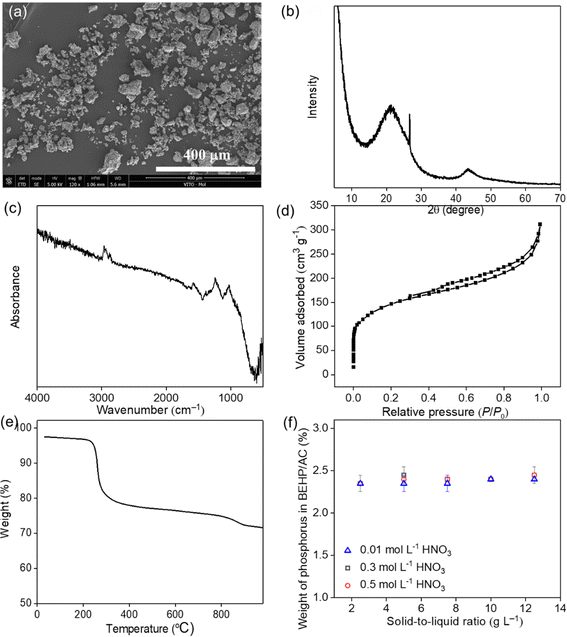 | ||
| Fig. 1 SEM image (a), XRD pattern (b), FT-IR spectrum (c), N2 sorption curve (d), TGA curve (e), and phosphorus leaching (f) of HDEHP/AC. | ||
The elemental analysis results (Table S1†) show that the percentage of P in the HDEHP/AC was 2.42 wt%, in addition to 82.8 wt% C, 3.14 wt% H, and 7 wt% O. Furthermore, the DRIFT spectrum (Fig. 1c) of HDEHP/AC contained characteristic bands at 1242 and 1028 cm−1, which were assigned to the P![[double bond, length as m-dash]](https://www.rsc.org/images/entities/char_e001.gif) O and P–O–C stretching modes, respectively.46,47 These results indicate that the HDEHP was immobilized onto the activated carbon structure. The introduction of HDEHP on the surface of activated carbons caused a decrease in their specific surface area from approximately 1000 m2 g−1 (as reported by Merck) to approximately 528 m2 g−1, as shown in Table S1† and Fig. 1d. The TGA curve (Fig. 1e) shows that the thermal decomposition of HDEHP/AC began at 230 °C. The mass loss of HDEHP/AC was about 18% up to 400 °C, which was due to the thermal decomposition of HDEHP. Beyond this point, the decomposition rate decreased before reaching ∼850 °C, indicating that the precursor of activated carbon probably had undergone a carbonization at high temperatures, particularly above 800 °C. Based on above characterization results, there are few other functional groups on the surface of activated carbon, and the primary functional group of HDEHP/AC is the phosphate group. Thus, HDEHP/AC can be used as a sorbent to examine the function of phosphate group and the carbon structure.
O and P–O–C stretching modes, respectively.46,47 These results indicate that the HDEHP was immobilized onto the activated carbon structure. The introduction of HDEHP on the surface of activated carbons caused a decrease in their specific surface area from approximately 1000 m2 g−1 (as reported by Merck) to approximately 528 m2 g−1, as shown in Table S1† and Fig. 1d. The TGA curve (Fig. 1e) shows that the thermal decomposition of HDEHP/AC began at 230 °C. The mass loss of HDEHP/AC was about 18% up to 400 °C, which was due to the thermal decomposition of HDEHP. Beyond this point, the decomposition rate decreased before reaching ∼850 °C, indicating that the precursor of activated carbon probably had undergone a carbonization at high temperatures, particularly above 800 °C. Based on above characterization results, there are few other functional groups on the surface of activated carbon, and the primary functional group of HDEHP/AC is the phosphate group. Thus, HDEHP/AC can be used as a sorbent to examine the function of phosphate group and the carbon structure.
For the sorbents, the loss of extractants from the impregnated materials into the liquid phase, due to the dissolution effect and/or mechanical force, was a concern.48 Therefore, leaching tests have been performed by contacting HDEHP/AC at different solid-to-liquid ratios and in the 0.01–0.5 mol L−1 HNO3 solutions for 150 h. Fig. 1f shows phosphorous content in HDEHP/AC after these leaching test, clearly demonstrating that HDEHP is not released from the carbon matrix in such conditions. A further possible reason for this stability was the low solubility of HDEHP in water and the weak HNO3 solutions.49
3.2. Sorption performance
The La3+ sorption percentage and Kd values rapidly increased at pH > 1.3. The sorption of La3+ onto the HDEHP/AC was primarily due to electrostatic attraction and surface complexation, which is associated with the deprotonated functional groups from HDEHP, known for its pKa of ∼1.47.52 Furthermore, as pH increases, the competitive sorption of decreased H+ on HDEHP decrease. Increasing the solid-to-liquid ratio (to 2 g L−1) shifted the increase in sorption capacity to lower pH (by merely 0.2 units), but the overall relationship was not impacted. This reconfirms that the sorption of La3+ onto HDEHP/AC was due to the electrostatic attraction/surface complexation and the decreased competitive effect of H+. The pH relation also indicates that the La3+ is expected to be desorbed via ion exchange with H+ in relatively low-pH solutions.
In contrast, the Bi3+ sorption percentage onto HDEHP/AC increases significantly at a lower pH compared to the increase in sorption capacity for La3+ and reaches more than 80% from a pH of 0.9. Increasing the pH further leads to a gradual increase in sorption capacity and related Kd values, due to the strong affinity of Bi3+ for the sorption active sites. This was probably due to the electrostatic repulsion between Bi3+ and protonated functional groups as well as the competitive sorption of excess H+ ions. Increasing the solid-to-liquid ratio leads to a minor shift to higher sorption capacities in the pH range between 0.6 and 1.6.
La3+ sorption was also examined over a broad pH range under a single system, as shown in Fig. 2b. The high sorption capacity of HDEHP/AC toward La3+ could be achieved at a higher pH value.
Based upon the measured sorption capacity, some estimates can be made for an actual 225Ac/213Bi generator. In case 4 GBq 225Ac is loaded onto a column, which corresponds to 8.279 nmol of 225Ac, only a minor amount of HDEHP/AC as sorbent should be sufficient for full sorption. The pH relationship also offers some insight in the potential use of HDEHP/AC. As selective Bi3+ sorption occurs at low pH (pH < 1), HDEHP/AC could be used in an inverse generator. For a direct generator approach, the pH and the solid-to-liquid ratio can be increased to facilitate the sorption of both Bi3+ and La3+.
According to above results, we inferred that controlling the separation pH (e.g., pH = 0.6) is expected to facilitate the selective uptake of Bi3+ from a La3+(Ac3+)/Bi3+ mixed solution onto the inverse separation column filled with HDEHP/AC sorbent. The use of sorbents with phosphate functional groups in the inverse generators is expected to align with our previous research.34 For the direct separation column, when the pH > 2 or 3, a high sorption capacity for La3+ (Ac3+) onto HDEHP/AC is expected to be achieved by increasing the pH and solid-to-liquid ratio.
Also these results indicate the potential in a generator, in which Bi3+ can be selectively eluted from the column at a relatively high pH (e.g., pH = 2), with minimal effect on the La3+ sorption. One possible reason for this phenomenon was the electrostatic repulsion that likely occurred between the negatively charged Bi-anion complexes and the deprotonated functional groups, which were also negatively charged.54,55 Furthermore, lowering the pH could elute the high Bi3+ in a relatively low concentration of NaCl, but this process also resulted in the elution of most of the La3+ from HDEHP/AC.
The profound effect of chloride ions on the sorption performance is also noticed for iodide. Fig. 4b shows the very high La3+ sorption capacity (>98%) in the presence of NaI concentrations in the range of 0.1 to 0.5 mol L−1 (at pH = 2). Similar to NaCl, increasing the NaI concentration drastically decreases the Bi3+ sorption capacity, due to the formation of Bi-iodide complexes which seem to have an even lower affinity compared to the Bi-chloride complexes. In summary, the halide ions (e.g., Cl− and I−) are expected to selectively elute 213Bi from the direct 225Ac/213Bi columns, resulting in the electrostatic repulsion between the Bi-halide anions and the negatively charged phosphate groups.54,55
The sorption of La3+ was distinctly higher in the single system than in the binary system at the corresponding time points, indicating that the presence of Bi3+ had a significant effect on the La3+ sorption. This was because most of the sorption sites were occupied by Bi3+. However, in practical applications, the concentration of Bi3+ is expected to be much lower than that of La3+ due to the high specific activity of 213Bi3+ compared to 225Ac3+. As such, the negative impact of Bi3+ on the La3+ sorption percentage would be less pronounced, as seen in Fig. 5a. By contrast, the Bi3+ sorption was not influenced by the presence of La3+, which was attributed to the high affinity of HDEHP/AC for Bi3+ as well as the fast kinetic interaction times.
Pseudo-first-order, pseudo-second-order, intraparticle diffusion and Elovich sorption kinetic models were applied to fit the experimental data and to obtain insight into the underlying sorption mechanism.39–41 The fitting parameters are shown in Table S2.† In the single system (Fig. 5b), the pseudo-second-order equation had high correlation coefficient values that indicated its suitability for illustrating the sorption process of La3+ and Bi3+ onto the HDEHP/AC. A similar result was obtained in the binary system (Fig. 5c). Based on the pseudo-second-order equation, the qe (La3+) in the single system (5.590 μmol g−1) was higher than that in the binary system (4.069 μmol g−1), suggesting that competitive sorption occurred. There were no obvious changes in Bi3+ sorption, indicating the weak competition of La3+ for Bi3+. Furthermore, compared to the pseudo-first-order and pseudo-second-order models, the intraparticle diffusion model was not suitable for the kinetic results due to its low R2 value (Fig. 5d). Interestingly, the Elovich model provided a better fit the kinetic data of La3+ among the four models (Fig. 5d). Based on these comparisons, it can be concluded that the kinetic behavior for La3+ can be described by the Elovich model, while the pseudo-second-order is more appropriate for Bi3+.
3.3. Desorption performance
The recycling of 225Ac is also an essential step for the generator column, as most functional groups are susceptible to radiolytic damage. Additionally, in the direct system, reducing the contact time is an effective way to minimize the dose received by the sorbents. This study investigated the effectiveness of the HNO3 solution in desorbing La3+ from the HDEHP/AC. Fig. 9a shows that 0.1 mol L−1 HNO3 solution could desorb nearly 90% of the La3+, while almost all of the La3+ on HDEHP/AC could be desorbed using 0.2–0.3 mol L−1 HNO3 solution. Considering the influence of ionic strength, 225Ac could be readily reused with a salt concentration of less than 0.5 mol L−1. An interesting finding was the relatively low desorption capacity of Bi3+, suggesting the potential use of HNO3 for the selective desorption of 225Ac in the inverse generator. This step could improve the purity of 213Bi without significantly affecting its yield. Fig. 9b shows the desorption of Bi3+ from HDEHP/AC at pH = 2, using NaI solution. The results show that the desorption percentage of Bi3+ increased with the NaI concentration increasing, while there was no desorption efficiency for La3+. This indicates that the Bi3+ could be selectively desorbed.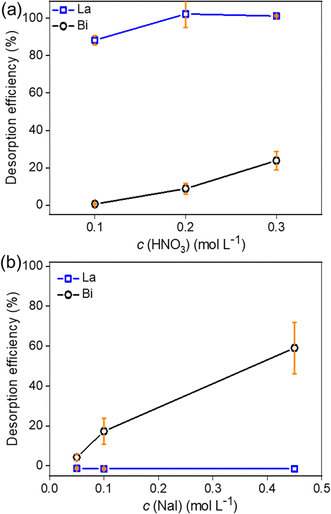 | ||
| Fig. 9 The desorption efficiency of La3+ and Bi3+ from the HDEHP/AC as of function of HNO3 (a) concentration and NaI concentration (pH = 2) (b). | ||
3.4. Preliminary column test
To evaluate the 225Ac/213Bi separation performance for practical applications, a column test is needed. However, commercial HDEHP/AC consisted of an irregular powder with a broad particle size range, making it difficult to increase the flow rate of the solution due to the high-pressure stacking. Nevertheless, a preliminary column test was conducted to offer some guidance for further material design. The 213Bi yield was approximately 50% in the 5 mL of 1 mol L−1 NaI/0.01 mol L−1 HNO3 eluate, with the 225Ac impurity being less than 0.04%. The 213Bi yield was lower compared to previously used materials, due to the high surface areas of the carbon structures. Additionally, a high mass value of HDEHP/AC was used during the desorption process, resulting in low desorption efficiency. However, this result also indicates that the grafting of phosphate functional groups onto the carbon materials could serve as a potential candidate for use in the direct 225Ac/213Bi generators.3.5. Conceptual separation of 225Ac and 213Bi
The findings of this study suggest that the phosphate groups and carbon structure had the potential to serve as the active sites and support, respectively, for the 213Bi separation. Although commercial HDEHP/AC was unsuitable for practical use, the data obtained could serve as a reference for designing materials and optimizing separation processes. Shaped HDEHP/AC materials with a suitable range of particle sizes could be fabricated and utilized for 225Ac/213Bi separation. The conceptual separation of 225Ac and 213Bi based upon this material can be envisioned in several approaches.The first approach is a 2-column direct generator, as shown in Fig. 10a. The detailed separation process can be seen in the experimental section. The second column can be used for the further purification of 213Bi eluate. An alternative use in a direct generator, consists in the removal of two-thirds of the sorbent from the column for adsorbing 225Ac and 213Bi through batch experiments, and then the sorbents with 225Ac/213Bi can be placed back into the column.29 A guard column with AG MP-50 or its analog could also be employed to improve the purity of 213Bi. Before the sorbents experienced severe damage, the 225Ac could be readily eluted from HDEHP/AC using relatively weak acidic solutions compared to the AG MP-50.
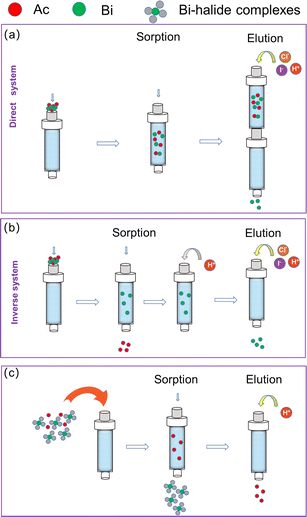 | ||
| Fig. 10 Conceptual separation process of the direct generator (a), inverse generator (b), and a possible method (c). | ||
The material holds also potential to be used in an inverse generator (see Fig. 10b). Bi3+ could be selectively adsorbed onto HDEHP/AC by adjusting the pH and salt concentrations. The purity of Bi3+ could be further improved by using 0.1–0.2 mol L−1 HNO3 to elute the possibly adsorbed 225Ac3+ before the 213Bi eluting step. This method could significantly reduce the radiolytic damage for the sorbents. Additionally, this separation is similar to the PNNL Bi-generator concept.11
HDEHP/AC also showed selective sorption of 225Ac, with minimal sorption capacity for Bi-halide complexes, as shown in Fig. 10c. When the 225Ac and 213Bi-halide complexes pass through the column, the 225Ac can be selectively adsorbed onto the column. The 213Bi can be obtained in a vial. Subsequently, the 225Ac can be eluted from the column for 213Bi ingrowth for use in the next cycle.
4. Conclusions
The study investigated the sorption and desorption behaviors of La3+ (as an analog for 225Ac) and Bi3+ by HDEHP/AC for the selective separation of 213Bi in medical applications. HDEHP/AC exhibited sorption toward La3+ via electrostatic attraction and surface complexation with a maximum sorption capacity of about 15 μmol g−1 (from the Langmuir model) at pH = 2, which could be further increased by increasing the pH values. The sorption of La3+ onto HDEHP/AC could be fitted by the Elvoich model. Further research shows that the La3+ sorption capacity decreased slightly or did not change as the NaCl and NaI concentrations increased, in contrast with the Bi3+ sorption capacity which decreased rapidly for Bi3+ owing to the formation of Bi-halide complexes. The desorption results show that the La3+ could be completely eluted from the sorbent via 0.2–0.3 mol L−1 HNO3 solutions from HDEHP/AC, which was likely to be beneficial in reducing the radiation damage to the direct column and for recycling undecayed 225Ac. Additionally, Bi3+ could be selectively adsorbed by HDEHP/AC at a low pH and relatively high NaNO3 concentration, and the HNO3 could be used to further improve the 213Bi purity in the inverse generator. Simultaneously, large amounts of Bi3+ are expected to be eluted by halide ions at a low pH (e.g., pH = 0.5) from the inverse columns. Therefore, HDEHP/AC showed promise for application in direct and inverse 225Ac/213Bi generators. However, commercial HDEHP/AC is an irregular powder with a broad particle size range and a high specific surface area, limiting its application in column chromatography. Further research should be dedicated towards the development if synthesis routes to graft phosphate groups onto shaped carbon materials (or alternatives) and to optimize the separation process conditions.Data availability
The data supporting this article have been included as part of the ESI.†Conflicts of interest
The authors declare that they have no known competing financial interests or personal relationships that could have appeared to influence the work reported in this paper.Acknowledgements
The SCK CEN and VITO are acknowledged for funding. Furthermore, the authors would like to acknowledge the technical assistance of P. Verheyen (ICP-MS), K. Raymond (SEM), K. Zhang & V. Meynen (DRIFT), M. Mertens (XRD), A. De Wilde (N2 sorption and TGA-MS), and J. De Wit (CHN analysis).References
- G. Sgouros, L. Bodei, M. R. McDevitt and J. R. Nedrow, Radiopharmaceutical therapy in cancer: clinical advances and challenges, Nat. Rev. Drug Discov., 2020, 19, 589–608 CrossRef CAS PubMed.
- Targeted Alpha Therapy Working Group, C. Parker, V. Lewington, N. Shore, C. Kratochwil, M. Levy, O. Linden, W. Noordzij, J. Park and F. Saad, Targeted Alpha Therapy, an Emerging Class of Cancer Agents: A Review, JAMA Oncol., 2018, 4, 1765–1772 CrossRef PubMed.
- H. Zhu, S. Heinitz, K. Binnemans, S. Mullens and T. Cardinaels, 225Ac/213Bi radionuclide generators for the separation of 213Bi towards clinical demands, Inorg. Chem. Front., 2024, 11, 4499–4527 RSC.
- A. Morgenstern, C. Apostolidis, C. Kratochwil, M. Sathekge, L. Krolicki and F. Bruchertseifer, An Overview of Targeted Alpha Therapy with 225Actinium and 213Bismuth, Curr. Rad., 2018, 11, 200–208 CAS.
- A. K. H. Robertson, C. F. Ramogida, P. Schaffer and V. Radchenko, Development of 225Ac Radiopharmaceuticals: TRIUMF Perspectives and Experiences, Curr. Rad., 2018, 11, 156–172 Search PubMed.
- S. Ahenkorah, I. Cassells, C. M. Deroose, T. Cardinaels, A. R. Burgoyne, G. Bormans, M. Ooms and F. Cleeren, Bismuth-213 for Targeted Radionuclide Therapy: From Atom to Bedside, Pharmaceutics, 2021, 13, 599 CrossRef CAS PubMed.
- C. Kratochwil, F. L. Giesel, F. Bruchertseifer, W. Mier, C. Apostolidis, R. Boll, K. Murphy, U. Haberkorn and A. Morgenstern, 213Bi-DOTATOC receptor-targeted alpha-radionuclide therapy induces remission in neuroendocrine tumours refractory to beta radiation: a first-in-human experience, Eur. J. Nucl. Med. Mol. Imag., 2014, 41, 2106–2119 CrossRef CAS PubMed.
- S. Ermolaev, A. Skasyrskaya and A. Vasiliev, A Radionuclide Generator of High-Purity Bi-213 for Instant Labeling, Pharmaceutics, 2021, 13, 914 CrossRef CAS PubMed.
- A. N. Vasiliev, V. A. Zobnin, Y. S. Pavlov and V. M. Chudakov, Radiation Stability of Sorbents in Medical 225Ac/213Bi Generators, Solvent Extr. Ion Exch., 2020, 39, 353–372 CrossRef.
- M. R. McDevitt, R. D. Finn, G. Sgouros, D. Ma and D. A. Scheinberg, An 225Ac/213Bi generator system for therapeutic clinical applications: construction and operation, Appl. Radiat. Isot., 1999, 50, 895–904 CrossRef CAS PubMed.
- L. A. Bray, J. M. Tingey, J. R. DesChane, O. B. Egorov, T. S. Tenforde, D. S. Wilbur, D. K. Hamlin and P. M. Pathare, Development of a Unique Bismuth (Bi-213) Automated Generator for Use in Cancer Therapy, Ind. Eng. Chem. Res., 2000, 39, 3189–3194 CrossRef CAS.
- V. Beaugeard, J. Muller, A. Graillot, X. Ding, J.-J. Robin and S. Monge, Acidic polymeric sorbents for the removal of metallic pollution in water: A review, React. Funct. Polym., 2020, 152, 104599 CrossRef CAS.
- M. W. Geerlings, F. M. Kaspersen, C. Apostolidis and R. V. Der Hout, The feasibility of 225Ac as a source of α-particles in radioimmunotherapy, Nucl. Med. Commun., 1993, 14, 121–125 CrossRef CAS PubMed.
- A. Morgenstern, F. Bruchertseifer and C. Apostolidis, Bismuth-213 and Actinium-225 – Generator Performance and Evolving Therapeutic Applications of Two Generator-Derived Alpha-Emitting Radioisotopes, Curr. Rad., 2012, 5, 221–227 CAS.
- H. Zhu, S. Heinitz, S. Eyley, W. Thielemans, E. Derveaux, P. Adriaensens, K. Binnemans, S. Mullens and T. Cardinaels, Gamma radiation effects on AG MP-50 cation exchange resin and sulfonated activated carbon for bismuth-213 separation, RSC Adv., 2023, 13, 30990–31001 RSC.
- C. Apostolidis, B. Brandalise, R. Carlos-Marquez, W. Janssens, R. Molinet and T. Nikula, Method of loading a radioelement generator with mother radionuclide, US Pat., US2005/0008553, 2005 Search PubMed.
- L. M. Arrigo, J. Jiang, Z. S. Finch, J. M. Bowen, C. L. Beck, J. I. Friese, L. R. Greenwood and B. N. Seiner, Development of a separation method for rare earth elements using LN resin, J. Radioanal. Nucl. Chem., 2020, 327, 457–463 CrossRef.
- C. D. Smith and M. L. Dietz, Support loading effects on the performance of an extraction chromatographic resin: Toward improved separation of trivalent lanthanides, Talanta, 2021, 222, 121541 CrossRef CAS PubMed.
- X. Huang, J. Dong, L. Wang, Z. Feng, Q. Xue and X. Meng, Selective recovery of rare earth elements from ion-adsorption rare earth element ores by stepwise extraction with HEH(EHP) and HDEHP, Green Chem., 2017, 19, 1345–1352 RSC.
- S. S. Kumar, A. Rao, K. K. Yadav, R. K. Lenka, D. K. Singh and B. S. Tomar, Selective removal of Am(III) and Pu(IV) from analytical waste solutions of quality control operations using extractant encapsulated polymeric beads, J. Radioanal. Nucl. Chem., 2020, 324, 375–384 CrossRef CAS.
- E. P. Horwitz, R. Chiarizia and M. L. Dietz, DIPEX: A new extraction chromatographic material for the separation and preconcentration of actinides from aqueous solution, React. Funct. Polym., 1997, 33, 25–36 CrossRef CAS.
- W. Wang and C. Y. Cheng, Separation and purification of scandium by solvent extraction and related technologies: a review, J. Chem. Technol. Biotechnol., 2011, 86, 1237–1246 CrossRef CAS.
- K. K. S. Pillay, A review of the radiation stability of ion exchange materials, J. Radioanal. Nucl. Chem., 1986, 102, 247–268 CrossRef CAS.
- M. Chen, Z. Li, Y. Geng, H. Zhao, S. He, Q. Li and L. Zhang, Adsorption behavior of thorium on N,N,N′,N′-tetraoctyldiglycolamide (TODGA) impregnated graphene aerogel, Talanta, 2018, 181, 311–317 CrossRef CAS PubMed.
- T. Kawamura, H. Wu and S.-Y. Kim, Adsorption and separation behavior of strontium and yttrium using a silica-based bis(2-ethylhexyl) hydrogen phosphate adsorbent, J. Radioanal. Nucl. Chem., 2021, 329, 1001–1009 CrossRef CAS.
- Q. Shu, A. Khayambashi, X. Wang, X. Wang, L. Feng and Y. Wei, Effects of γ irradiation on bis(2-ethylhexyl)phosphoric acid supported by macroporous silica-based polymeric resins, Radiochim. Acta, 2018, 106, 249–258 CrossRef CAS.
- V. Ostapenko, A. Vasiliev, E. Lapshina, S. Ermolaev, R. Aliev, Y. Totskiy, B. Zhuikov and S. Kalmykov, Extraction chromatographic behavior of actinium and REE on DGA, Ln and TRU resins in nitric acid solutions, J. Radioanal. Nucl. Chem., 2015, 306, 707–711 CrossRef CAS.
- N.-E. Belkhouche and N. Benyahia, Modeling of Adsorption of Bi(III) from Nitrate Medium by Impregnated Resin D2EHPA/XAD-1180, J. Surf. Eng. Mater. Adv. Technol., 2011, 01, 30–34 CAS.
- C. Wu, M. W. Brechbiel and O. A. Gansow, An Improved Generator for the Production of 213Bi from 225Ac, Radiochim. Acta, 1997, 79, 141–144 CrossRef CAS.
- W. Yantasee, G. E. Fryxell, K. Pattamakomsan, T. Sangvanich, R. J. Wiacek, B. Busche, R. S. Addleman, C. Timchalk, W. Ngamcherdtrakul and N. Siriwon, Selective capture of radionuclides (U, Pu, Th, Am and Co) using functional nanoporous sorbents, J. Hazard. Mater., 2019, 366, 677–683 CrossRef CAS PubMed.
- W. A. Abbasi and M. Streat, Sorption of uranium from nitric acid solution using TBP-impregnated activated carbons, Solvent Extr. Ion Exch., 1998, 16, 1303–1320 CrossRef CAS.
- E. P. Horwitz and C. A. A. Bloomquist, Chemical separations for super-heavy element searches in irradiated uranium targets, J. Inorg. Nucl. Chem., 1975, 37, 425–434 CrossRef CAS.
- L. Ondrák, K. Ondrák Fialová, M. Sakmár, M. Vlk, F. Bruchertseifer, A. Morgenstern and J. Kozempel, Development of 225Ac/213Bi generator based on α-ZrP-PAN composite for targeted alpha therapy, Nucl. Med. Biol., 2024, 132–133, 108909 CrossRef PubMed.
- H. Zhu, S. Heinitz, S. Eyley, W. Thielemans, K. Binnemans, S. Mullens and T. Cardinaels, Sorption and desorption performance of La3+/Bi3+ by surface-modified activated carbon for potential application in medical 225Ac/213Bi generators, Chem. Eng. J., 2023, 464, 142456 CrossRef CAS.
- F. Monroy-Guzman, C. d. C. De la Cruz Barba, E. Jaime Salinas, V. Garibay-Feblés and T. N. Nava Entzana, Extraction Chromatography Materials Prepared with HDEHP on Different Inorganic Supports for the Separation of Gadolinium and Terbium, Metals, 2020, 10, 1390 CrossRef CAS.
- E. A. El-Sofany, W. F. Zaher and H. F. Aly, Sorption potential of impregnated charcoal for removal of heavy metals from phosphoric acid, J. Hazard. Mater., 2009, 165, 623–629 CrossRef CAS PubMed.
- Z. Heidarinejad, M. H. Dehghani, M. Heidari, G. Javedan, I. Ali and M. Sillanpää, Methods for preparation and activation of activated carbon: a review, Environ. Chem. Lett., 2020, 18, 393–415 CrossRef CAS.
- A. A. Ichou, R. Benhiti, M. Abali, A. Dabagh, G. Carja, A. Soudani, M. Chiban, M. Zerbet and F. Sinan, Characterization and sorption study of Zn2[FeAl]-CO3 layered double hydroxide for Cu(II) and Pb(II) removal, J. Solid State Chem., 2023, 320, 123869 CrossRef.
- S. K. Lagergren, About the Theory of So-called Adsorption of Soluble Substances, Kungliga Svenska Vetenskapsakademiens, Handlinger, 1898, 24, 1–19 Search PubMed.
- G. Blanchard, M. Maunaye and G. Martin, Removal of heavy metals from waters by means of natural zeolites, Water Res., 1984, 18, 1501–1507 CrossRef CAS.
- H. N. Tran, S.-J. You, A. Hosseini-Bandegharaei and H.-P. Chao, Mistakes and inconsistencies regarding adsorption of contaminants from aqueous solutions: A critical review, Water Res., 2017, 120, 88–116 CrossRef CAS PubMed.
- I. Langmuir, The adsorption of gases on plane surfaces of glass, mica and platinum, J. Am. Chem. Soc., 1918, 40, 1361–1403 CrossRef CAS.
- H. Freundlich, Über die Adsorption in Lösungen, Z. Phys. Chem., 1907, 57U, 385–470 CrossRef.
- Y. choi, Y. Kim, K. Y. Kang and J. S. Lee, A composite electrolyte membrane containing high-content sulfonated carbon spheres for proton exchange membrane fuel cells, Carbon, 2011, 49, 1367–1373 CrossRef CAS.
- M. Okamura, A. Takagaki, M. Toda, J. N. Kondo, K. Domen, T. Tatsumi, M. Hara and S. Hayashi, Acid-Catalyzed Reactions on Flexible Polycyclic Aromatic Carbon in Amorphous Carbon, Chem. Mater., 2006, 18, 3039–3045 CrossRef CAS.
- G. J. Lumetta, S. I. Sinkov, J. A. Krause and L. E. Sweet, Neodymium(III) Complexes of Dialkylphosphoric and Dialkylphosphonic Acids Relevant to Liquid-Liquid Extraction Systems, Inorg. Chem., 2016, 55, 1633–1641 CrossRef CAS PubMed.
- Q. Shu, A. Khayambashi, X. Wang and Y. Wei, Studies on adsorption of rare earth elements from nitric acid solution with macroporous silica-based bis(2-ethylhexyl)phosphoric acid impregnated polymeric adsorbent, Adsorpt. Sci. Technol., 2018, 36, 1049–1065 CrossRef CAS.
- J.-H. Chen, W.-R. Chen, Y.-Y. Gau and C.-H. Lin, The preparation of di(2-ethylhexyl) phosphoric acid modified Amberlite 200 and its application in the separation of metal ions from sulfuric acid solution, React. Funct. Polym., 2003, 56, 175–188 CrossRef CAS.
- C. D. Smith, F. H. Foersterling and M. L. Dietz, Solvent structural effects on the solubility of bis(2-ethylhexyl)phosphoric acid (HDEHP) in room-temperature ionic liquids, Separ. Sci. Technol., 2020, 56, 800–810 CrossRef.
- W. Wang, R. Y. Park, D. H. Meyer, A. Travesset and D. Vaknin, Ionic specificity in pH regulated charged interfaces: Fe3+versus La3+, Langmuir, 2011, 27, 11917–11924 CrossRef CAS PubMed.
- B. V. Egorova, M. S. Oshchepkov, Y. V. Fedorov, O. A. Fedorova, G. S. Budylin, E. A. Shirshin and S. N. Kalmykov, Complexation of Bi3+, Ac3+, Y3+, Lu3+, La3+ and Eu3+ with benzo-diaza-crown ether with carboxylic pendant arms, Radiochim. Acta, 2016, 104, 555–565 CrossRef CAS.
- D. Depuydt, A. Van den Bossche, W. Dehaen and K. Binnemans, Halogen-free synthesis of symmetrical 1,3-dialkylimidazolium ionic liquids using non-enolisable starting materials, RSC Adv., 2016, 6, 8848–8859 RSC.
- B. D. Coday, T. Luxbacher, A. E. Childress, N. Almaraz, P. Xu and T. Y. Cath, Indirect determination of zeta potential at high ionic strength: Specific application to semipermeable polymeric membranes, J. Membr. Sci., 2015, 478, 58–64 CrossRef CAS.
- B. Y. Spivakov, E. S. Stoyanov, L. A. Gribov and Y. A. Zolotov, Raman laser spectroscopic studies of bismuth(III) halide complexes in aqueous solutions, J. Inorg. Nucl. Chem., 1979, 41, 453–455 CrossRef CAS.
- O. Horváth and I. Mikó, Spectra, equilibrium and photoredox chemistry of iodobismuthate(III) complexes in acetonitrile, Inorg. Chim. Acta, 2000, 304, 210–218 CrossRef.
- C. M. Babu, K. Binnemans and J. Roosen, Ethylenediaminetriacetic Acid-Functionalized Activated Carbon for the Adsorption of Rare Earths from Aqueous Solutions, Ind. Eng. Chem. Res., 2018, 57, 1487–1497 CrossRef CAS.
- N. A. Thiele and J. J. Wilson, Actinium-225 for Targeted alpha Therapy: Coordination Chemistry and Current Chelation Approaches, Cancer Biother. Rad., 2018, 33, 336–348 Search PubMed.
- R. G. Pearson, Absolute electronegativity and hardness: application to inorganic chemistry, Inorg. Chem., 1988, 27, 734–740 CrossRef CAS.
- R. G. Parr and R. G. Pearson, Absolute hardness: companion parameter to absolute electronegativity, J. Am. Chem. Soc., 1983, 105, 7512–7516 CrossRef CAS.
Footnote |
| † Electronic supplementary information (ESI) available. See DOI: https://doi.org/10.1039/d4ra06276k |
| This journal is © The Royal Society of Chemistry 2024 |

